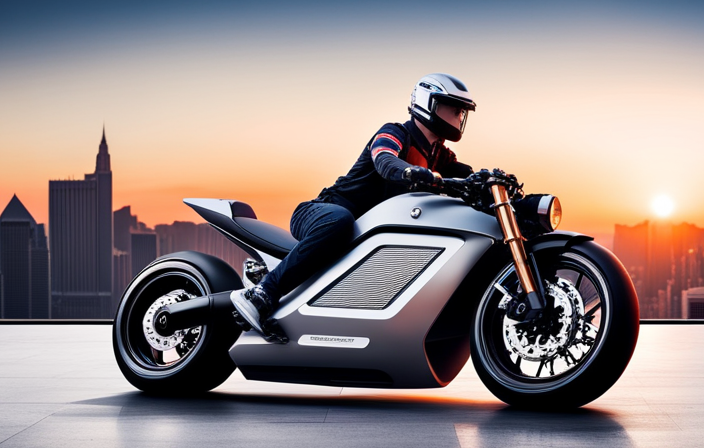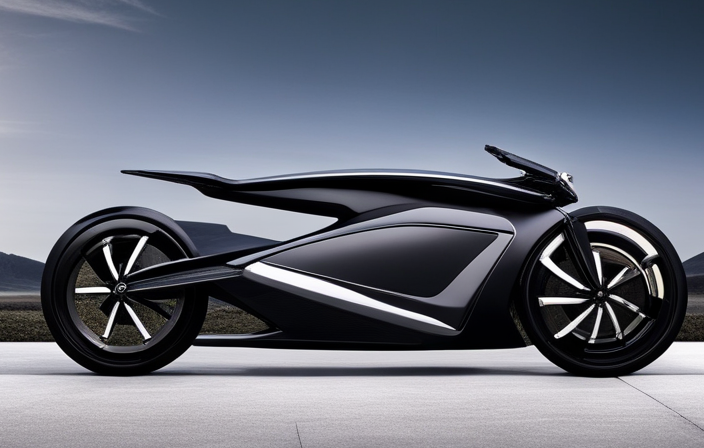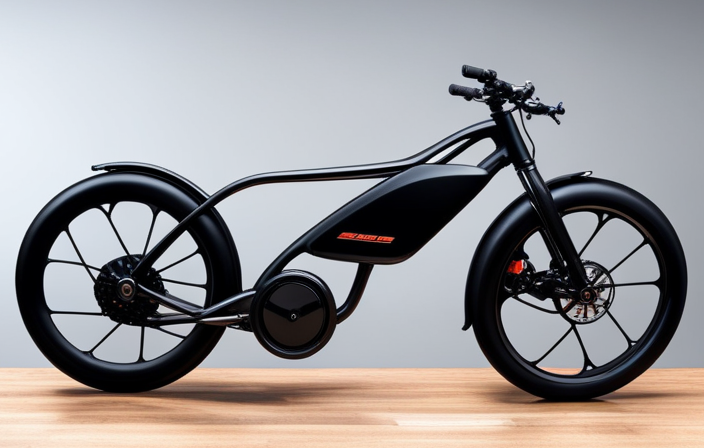Imagine cruising down the streets on a bike that is not only eco-friendly but also powered by the sun. With a solar electric bike, you can experience the thrill of riding while reducing your carbon footprint.
In this article, we will guide you through the process of making your own solar electric bike at home. From understanding the benefits to choosing the right bike and installing the solar panels, we will provide you with detailed and practical steps to help you embark on this exciting project.
Get ready to revolutionize your ride!
Key Takeaways
- Benefits of a solar electric bike include eco-friendly transportation, reduced carbon footprint, cost savings on fuel, and the use of a renewable energy source.
- Gathering the necessary tools and materials such as lightweight and durable solar panels, compatible electrical components, a solar charge controller, battery and inverter, and motor controller.
- Choosing the right bike for conversion involves considering frame size and weight capacity, potentially upgrading components, and battery capacity for range and power.
- Preparing the bike for conversion includes removing unnecessary components, reinforcing the frame, creating mounting points for solar panels, and ensuring maximum sunlight exposure for the panels.
Understanding the Benefits of a Solar Electric Bike
You’ll love the many benefits of having a solar electric bike.
Exploring solar energy is not only environmentally friendly but also cost-effective in the long run.
With a solar electric bike, you can harness the power of the sun to charge your bike’s battery, reducing your reliance on fossil fuels and saving money on fuel costs.
Additionally, solar energy is a renewable resource, meaning it will never run out, unlike non-renewable energy sources.
Understanding renewable transportation is crucial in today’s world, where the need for sustainable alternatives is increasing.
By using a solar electric bike, you contribute to reducing carbon emissions and promoting a greener and healthier planet.
Now that you understand the benefits of a solar electric bike, let’s move on to gathering the necessary tools and materials for building one.
Gathering the Necessary Tools and Materials
To begin, gather all the needed tools and materials for your DIY project. Choosing the right solar panels is crucial for the success of your solar electric bike. Look for panels that are lightweight, durable, and efficient in converting sunlight into electricity. Monocrystalline or polycrystalline panels are commonly used for this purpose. Additionally, ensure that the solar panels you choose are compatible with the electrical components you will be using.
Sourcing the necessary electrical components is the next step. You will need a solar charge controller, a battery, an inverter, and a motor controller. Research and compare different options to find the best components that fit your budget and requirements.
Once you have gathered all the tools and materials, you can move on to the next section about choosing the right bike for conversion.
Choosing the Right Bike for Conversion
When selecting a suitable bicycle for your project, consider factors such as frame size, weight capacity, and overall condition. Upgrading components, such as brakes, gears, and tires, may be necessary to ensure the bike can handle the added weight of the solar electric conversion. Additionally, the battery capacity is an important consideration as it determines the range and power of your electric bike. To help you visualize the process, here is a table summarizing the key features to look for in a bike for conversion:
| Factor | Description |
|---|---|
| Frame Size | Choose a frame that fits your height and riding style. |
| Weight Capacity | Ensure the bike can support the weight of the solar panels and battery. |
| Overall Condition | Look for a bike in good condition to minimize the need for repairs. |
With the right bike in hand, you can now proceed to the next step of preparing the bike for the solar electric conversion.
Preparing the Bike for the Solar Electric Conversion
Once you have chosen a suitable bicycle for your project, it’s time to prepare it for the solar electric conversion. Here are three important steps to get your bike ready for the modification:
-
Remove unnecessary components: Start by stripping down your bike to its basic frame. Take off any unnecessary parts like gears, chains, and brakes that will not be needed for the electric conversion. This will make the bike lighter and easier to work with.
-
Reinforce the frame: Since the bike will now carry the weight of the solar panels and batteries, it’s crucial to reinforce the frame. Use metal brackets, welding, or additional support bars to strengthen the frame and ensure it can handle the added weight.
-
Create mounting points: To install the solar panels, you’ll need to create mounting points on the bike frame. These can be made from metal or sturdy plastic and should be positioned in a way that allows for maximum sunlight exposure.
Once you have prepared your bike, the next step is to install the solar panels and transform it into a solar electric bike.
Installing the Solar Panels
Now that you have prepared your bike, it’s time to install the solar panels and complete the transformation. Installing solar panels on your bike will allow you to harness the power of the sun and convert it into electricity to power your bike. The process may seem daunting, but with the right tools and guidance, it can be done easily.
To begin, gather the necessary materials: solar panels, mounting brackets, screws, and a drill. Start by determining the best location for the panels on your bike. Ideally, they should be placed on a flat surface where they can receive maximum sunlight. Once you have decided on the location, use the mounting brackets and screws to securely attach the panels to your bike.
Next, you will need to make the wiring connections. Connect the positive terminal of the solar panels to the positive terminal of the battery, and the negative terminal of the panels to the negative terminal of the battery. Use appropriate connectors and wires to ensure a secure and efficient connection.
With the solar panels installed and the wiring connections made, you are now ready to move on to connecting the solar panels to the bike’s battery. This will allow the electricity generated by the panels to be stored and used to power your bike.
Connecting the Solar Panels to the Bike’s Battery
To connect the solar panels to the bike’s battery, you’ll need to ensure a secure and efficient wiring connection. Here are four important steps to follow:
-
Gather the necessary materials: You’ll need a charge controller, wires, connectors, and a fuse holder with a fuse.
-
Connect the charge controller: Connect the solar panels to the charge controller using the provided wires and connectors. Make sure to follow the manufacturer’s instructions for proper connection.
-
Connect the charge controller to the battery: Attach the charge controller’s positive and negative wires to the corresponding terminals on the bike’s battery. Ensure a tight and secure connection.
-
Install a fuse: Connect a fuse holder with a fuse between the charge controller and the battery to protect the system from overcharging or short-circuiting.
After connecting the solar panels to the bike’s battery, you’ll be ready to move on to the next step of adding a motor for electric assistance.
[Transition sentence] Now, let’s explore how to add a motor for electric assistance to your solar electric bike.Adding a Motor for Electric Assistance
Adding a motor for electric assistance requires careful consideration of the bike’s specifications and compatibility. Before proceeding with the electric conversion, determine the motor power you need based on your desired level of assistance. Look for a motor that matches the voltage and wattage requirements of your bike’s battery.
Consider the weight and size of the motor to ensure it can be easily mounted onto your bike frame. Additionally, check if any modifications are needed to install the motor, such as adding a motor bracket or modifying the chain drive.
Once you have chosen the appropriate motor, you can proceed to the next step of wiring and electrical connections. This involves connecting the motor to the battery and control system, allowing you to control the electric assistance.
Wiring and Electrical Connections
Once you’ve chosen the appropriate motor, you can proceed with wiring and connecting the electrical components. Proper electrical connections are crucial for the functioning of your solar electric bike. To help you understand the wiring techniques, here is a table outlining the necessary connections:
| Component | Wire Connection |
|---|---|
| Battery | Positive to + |
| Negative to – | |
| Motor | Positive to + |
| Controller | Negative to – |
| Solar Panel | Positive to + |
| Negative to – |
Make sure to use high-quality wires and connectors to ensure a secure and efficient electrical connection. Properly insulate the connections to prevent any short circuits or damage. Once you have completed the wiring and electrical connections, you can move on to testing and troubleshooting the system.
Testing and Troubleshooting
Before moving on to testing and troubleshooting, it’s important to ensure that all the wiring and electrical connections have been completed accurately and securely.
Once you have completed the wiring, it’s time to test your solar electric bike. Start by checking if all the lights and indicators are functioning properly. If any of them are not working, double-check the connections and replace any faulty components.
Next, test the throttle and make sure it responds smoothly without any jerks or delays. If there are any issues, check the wiring connections to the throttle and the controller.
Additionally, listen for any unusual noises coming from the motor or other components. This could indicate a problem with the motor or the wiring.
By following these troubleshooting tips and addressing common problems, you can ensure that your solar electric bike is functioning optimally and ready for the next step in optimizing its performance.
Optimizing the Solar Electric Bike’s Performance
To improve the performance of your solar electric bike, it’s important to regularly maintain and inspect the various components. Here are some practical tips to help you optimize its efficiency and increase power output:
- Make sure the solar panels are clean and free from any debris, as this can significantly impact their ability to generate electricity.
- Check the battery regularly and ensure it’s charged properly. A well-maintained battery will provide optimal power to the motor.
- Inspect the wiring connections to ensure they are secure and free from any damage. Loose or damaged wires can lead to power loss and decreased performance.
- Consider upgrading to more efficient and powerful motor and battery options, depending on your budget and needs.
By implementing these steps, you can enhance the overall performance of your solar electric bike.
Now let’s move on to the next section, where we will discuss safety considerations and precautions to keep in mind.
Safety Considerations and Precautions
It’s important to prioritize safety when using and maintaining your solar electric bike. To ensure a safe and enjoyable riding experience, there are several safety measures and precautionary steps you should take.
Firstly, always wear a helmet and other protective gear to protect yourself in case of a fall or accident. Additionally, make sure the bike’s brakes are in good working condition and regularly check the tire pressure to ensure proper traction. When riding on the road, obey traffic rules and signals, and always be aware of your surroundings.
It’s also crucial to perform regular maintenance checks on the bike’s electrical components, such as the battery and wiring, to prevent any potential hazards. By following these safety precautions, you can ride your solar electric bike with confidence and peace of mind.
Now, let’s move on to the next section about the maintenance and upkeep of your solar electric bike.
Maintenance and Upkeep of the Solar Electric Bike
Taking care of your solar electric bike is essential for its longevity and optimal performance. Here are some maintenance tips to help you keep your bike in top shape and prolong the battery life:
-
Regularly clean your solar panels to ensure maximum sunlight absorption. Use a soft cloth and mild soap to avoid scratching the surface.
-
Inspect the battery regularly for any signs of damage or corrosion. Clean the terminals with a mixture of baking soda and water to prevent buildup.
-
Keep your bike stored in a dry and cool place when not in use. Extreme temperatures can affect the battery’s performance.
By following these maintenance tips, you can ensure that your solar electric bike remains in great condition and continues to provide you with eco-friendly transportation.
Now, let’s explore how you can expand and upgrade your solar electric bike to further enhance its capabilities.
Expanding and Upgrading Your Solar Electric Bike
If you want to enhance your solar electric bike, you can consider expanding and upgrading its capabilities.
One way to do this is by upgrading the battery capacity. A larger battery will allow you to go longer distances without needing to recharge. Look for a battery with a higher Ampere-hour (Ah) rating to ensure extended power.
Another option is to increase the solar panel efficiency. Upgrading to more efficient solar panels will enable faster charging and better utilization of sunlight. Look for panels with higher power output and better conversion rates.
By upgrading both the battery capacity and solar panel efficiency, you can optimize the performance of your solar electric bike. This will ensure that you can ride longer distances and make the most of the available sunlight.
With these upgrades in place, you can now explore additional features and accessories to further enhance your solar electric bike’s functionality.
Additional Features and Accessories
To enhance your solar-powered bicycle, you can consider adding extra features and accessories. These additions can improve your overall riding experience and make your bike more functional.
Here are four items you might want to consider:
-
LED lights: Install LED lights to increase visibility and safety, especially when riding at night.
-
Rear rack: Attach a rear rack to carry items such as groceries or a backpack, making your bike more practical for daily use.
-
Phone holder: Mount a phone holder on your handlebars to easily access navigation or listen to music while riding.
-
Bike lock: Invest in a sturdy bike lock to secure your solar electric bike and prevent theft.
By customizing your solar-powered bicycle with these additional features, you can optimize its functionality and convenience.
Next, we’ll explore how to enjoy the benefits of your solar electric bike without any additional steps.
Enjoying the Benefits of Your Solar Electric Bike
One way to fully appreciate the advantages of your solar e-bike is by exploring new routes and experiencing the freedom of eco-friendly transportation.
Not only does your solar electric bike help reduce your carbon footprint, but it also offers a range of benefits that can enhance your riding experience.
To maximize efficiency, make sure to take advantage of solar charging stations whenever possible. These stations allow you to recharge your bike’s battery using renewable energy from the sun, ensuring that you have a constant and reliable power source.
By utilizing solar charging stations, you can extend the distance you can travel and enjoy longer rides without worrying about running out of battery power.
This practical approach to charging will allow you to fully enjoy the benefits of your solar electric bike.
Frequently Asked Questions
How much does it cost to convert a regular bike into a solar electric bike?
Converting a regular bike into a solar electric bike can vary in cost depending on the quality of components you choose. On average, you can expect to spend anywhere from $500 to $2000.
However, the benefits are worth it. By converting your bike, you can enjoy the advantages of using a solar electric bike over a traditional one.
These advantages include reduced pollution, cost savings on fuel, and the ability to travel longer distances without getting exhausted.
What is the average lifespan of a solar panel used on a solar electric bike?
The average lifespan of a solar panel used on a solar electric bike can vary depending on several factors. Generally, with proper maintenance, solar panels can last anywhere from 20 to 25 years.
To ensure longevity, it is important to regularly clean the panels and inspect for any damage. Additionally, protecting the panels from extreme weather conditions and providing adequate shading can help extend their lifespan.
Regular maintenance and care are crucial for maximizing the efficiency and lifespan of solar panels.
Can I charge the solar electric bike using a regular power outlet?
You can’t make a silk purse out of a sow’s ear, and similarly, you can’t charge a solar electric bike using a regular power outlet. The charging process requires a solar panel to harness the sun’s energy.
The efficiency of the solar panel plays a crucial role in the charging speed. To ensure optimal performance, it’s important to invest in high-quality solar panels with a good efficiency rating.
Are there any weight limitations for riders of a solar electric bike?
Weight limitations are an important factor to consider when riding a solar electric bike. Exceeding the recommended weight can lead to safety concerns and potential damage to the bike.
Most solar electric bikes have a weight limit of around 220-250 pounds, but this may vary depending on the specific model. It’s crucial to adhere to these limitations to ensure a smooth and safe riding experience.
Always check the manufacturer’s guidelines for the weight capacity of your solar electric bike.
Is it possible to ride a solar electric bike in rainy or cloudy weather?
Yes, it is possible to ride a solar electric bike in rainy or cloudy weather. The bike is designed to charge from a regular electrical outlet, so you can still use it even if the solar power is not sufficient.
The advantages of using solar power for electric bikes include reducing your carbon footprint and saving money on electricity bills.
Riding a solar electric bike in winter may require taking extra precautions, such as using winter tires and keeping the battery warm.
Conclusion
Congratulations on successfully creating your own solar electric bike! By harnessing the power of the sun, you have not only reduced your carbon footprint but also saved money on fuel costs.
Did you know that the average American spends over $1,000 a year on gas for their vehicle? With your solar electric bike, you can enjoy the freedom of transportation while being environmentally conscious and pocket-friendly.
Remember to continue maintaining and upgrading your bike to ensure its optimal performance. So, hop on your solar electric bike and start enjoying the benefits today!
















